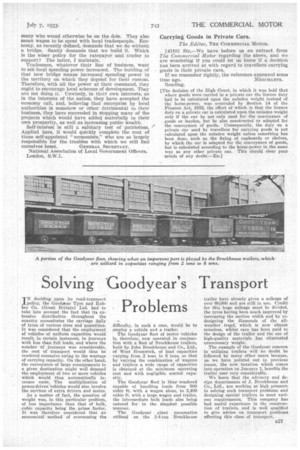Solving 'Goodyear's Transport Problems
Page 45

If you've noticed an error in this article please click here to report it so we can fix it.
IN deciding upon its road-transport policy, the Goodyear Tyre and Rubber Co. (Great Britain) Ltd. had to take into account the fact that its extensive distribution throughout the country necessitates the carriage daily of tyres of various sizes and quantities. It was considered that the employment of vehicles of uniform capacities would result, in certain instances, in journeys with less than full loads, and where the number of journeys was considerable, the cost of transport would thus be rendered excessive owing to the wastage of carrying capacity. On the other hand, the conveyance of large consignments to a given destination might well demand the employment of two or more vehicles which would thus automatically increase costs. The multiplication of power-driven vehicles would also involve the services of extra drivers and mates.
As a matter of fact, the question of weight was, in this particular problem, of less importance than that of bulk, cubic capacity being the prime factor. It was therefore considered that an economical method of overcoming the difficulty, in such a ease, would be to employ a vehicle and a trailer.
The Goodyear fleet of motor vehicles is, therefore, now operated in conjunction with a fleet of Brockhouse trailers, built by John Brockhouse and Co., Ltd., of West Bromwich, of load capacities varying from 2 tons to 8 tons, so that by varying the combination of wagons Cud trailers a wide range of capacities is obtained at the minimum operating cost and with negligible wasted capacity.
The Goodyear fleet is thus' rendered capable of handling loads from 900 cubic ft. with a wagon alone, to 2,400 cubic ft. with a large wagon and trailer, the intermediate bulk loads also being catered for in the simplest possible no anner.
The Goodyear giant pneumatics utilized on the 3-4-ton Brockhouse
trailer have already given a mileage of over 60,000 and are still in use. Credit for this huge mileage must be divided, the tyres having been much improved by increasing the section width and by redesigning the diamonds of the allweather tread, which is now almost noiseless, whilst care has been paid to the design of the trailer and the use of high-quality materials has eliminated unnecessary weight.
The example of the Goodyear concern in utilizing trailers will no doubt be followed by many other users because, as. we have pointed out in previous issues, the new taxation which comes into operation on January 1, benefits the trailer user very considerably.
We learn that the advisory and design departments of J. Brockhouse and Co., Ltd., are working at high pressure in solving such transport problems and designing special trailers to meet various requirements. This company has had useful experience in the construction of trailers, and is well qualified to give advice on transport problems affecting this class of transport.




































































































